For product requests contact us by using the
- Contact formular,
- Email (sales@suragus.com) or
- Phone (+49 351 32 111 520).
Anisotropy Measurement by Eddy Current Testing | What is Electrical Anisotropy? | Measurement
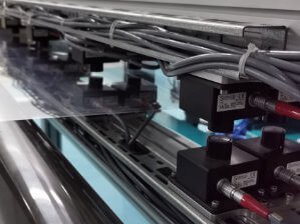
The measurement of electrical anisotropy by eddy current anisotropy sensors allows the precise measurement the anisotropy strength and anisotropy direction without sample preparation or even contacting the test object. The key of this innovation is the induction of directed eddy currents into thin films and the subsequent determination of directed sheet resistances by electromagnet field (EMF) sensors. Anisotropy sensors and instruments save a tremendous amount of time since a measurement can be done in milli-seconds. Further benefits include
This technology is applied in industrial applications since 2015. The dedicated EddyCus SR-A series includes single point, imaging and inline devices. Those systems determine the directed sheet resistance in two or four directions and present the data as numbers, graphical bars or as anisotropy images.
The available definitions of electrical anisotropy are often addressing the background of its application. The general definition of electrical anisotropy describes the variation of an electrical property depending on the lateral or vertical direction (x,y,z) in which is a current flows. In other words, the term “electrical anisotropy” describes the directional dependence of the electrical conductivity or resistivity or other electrical terms such as sheet resistance or carrier mobility. The scale of anisotropy can be microscopic or macroscopic and even be different on small and large scale.

The anisotropy depends on the material, the process type and process parameters. There are isotropic or rather isotropic processes such as PVD or CVD processes. There are also high throughput processes such as slot die coating or curtain coating which generate anisotropy depending on process parameters such as speed or if measures are taken to reduce or increase anisotropy. Furthermore, there are also high anisotropic applications e.g. screen printing in PV industry where the metal meshes structures (fingers) are designed for efficient current transport towards the collectors. An overview in typical anisotropy rations is given here.
| Isotropic processes | RMD = RTD |
| Anisotropic processes |
RMD < RTD RTD / RMD = 1.0 – 1.2 or 1.2 – 2.0 |
| Forced anisotropic processes (e.g. by mesh design) |
RMD << RTD RTD / RMD = 2 – 200 (and higher) |
The relevant directions for anisotropy calculation are the minimum (Rdirection min) and the maximum (Rdirection max) sheet resistance direction. Most inline manufacturing processes tend to align the wires into machine direction when transferring wire or tube material onto moving web. Therefore, the best or minimum sheet resistance is present in machine direction. Consequently, the worst or highest sheet resistance is achieved into the traversing direction.
Generally, the best sheet resistance direction Rdirection min is perpendicular to worst sheet resistance Rdirection max.
There are two common ways to describe anisotropy. Either the ration between the lowest and highest sheet resistance is taken. An alternative way is the description of the difference of both directions divided by the average.
Transparent conductive materials excel in electrical conductivity and in optical transparency at the same time. The challenge for TCM manufactures is that the electrical resistance can be improved by adding more material which is then worsening the transparency. Many companies compete for providing the best sheet resistance to transparency ratio. Nanowire, tube and mesh structure are able to provide outstanding SR to OT rations at good costs. There are some cases where the conductivity of a film is directed to the electrodes which results in even better SR to OT rations. The key points of this concept are shown here:
Anisotropic Wire Film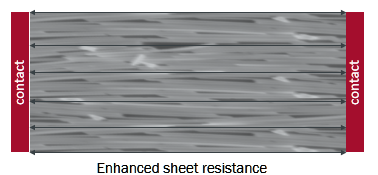 |
Isotropic Wire Film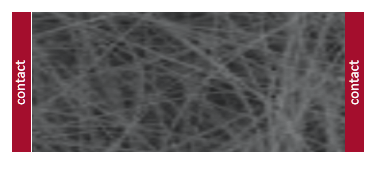 |
|
|
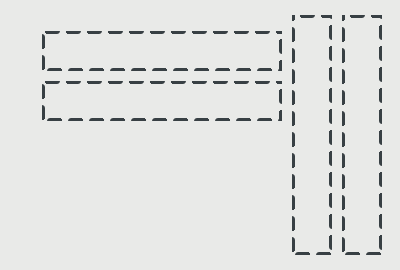
The measurement of the resistivity anisotropy may expose insights about the material structure and scattering processes in anisotropic and low-dimensional materials. Its anisotropy is affected by the geometry of conductors, its connection, the number contact points and length paths and the effective parallel resistances.
A difference in lateral (y,x) sheet resistance / resistivity / conductivity within a material or film can be measured by contact or non contact testing methods. Contact methods require the cut out of narrow and long material sections in a ration of 1 : 20 (eg. 1 cm x 20 cm). Here the direction of the cutout describes the direction measurement. The sheet resistance can be measured by contact measurement after applying contact pad to the material film. The nature of this setup results in the disadvantage that a measurement on the same position is not possible. The layout of possible cut outs is shown at the right.
Non-contact measurement of electrical anisotropy is done by SURAGUS Eddy Current anisotropy sensors. Those are especially designed to induce currents in defined directions such as MD = Machine Direction | TD - Transversal Direction. There are single point measurement systems and imaging measurement systems proving in detail information on anisotropy strength and direction across the entire sample. Examples for sheet resistance anisotropy depiction are shown below. The first images shows the individual sheet resistances RMD and RTD and the absolute and relative calculated values. The right image depicts the anisotropy distribution across a sample where blue represents anisotropic areas and red anisotropic areas. The black and white line image depicts the anisotropy strength as length of the lines where dots represent isotropic areas and long lines anisotropic areas. The direction of anisotropy is exposed by the direction of a line.
| Single point / inline | Imaging |
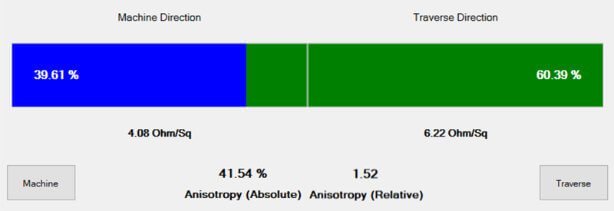
|
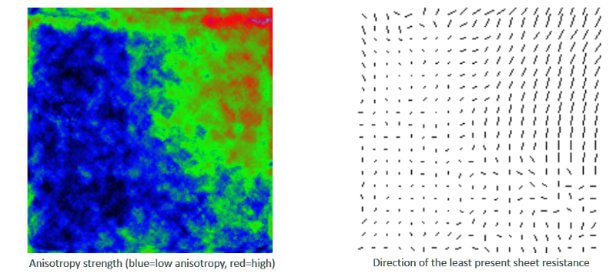
|
| Single Point Anisotropy Evaluation with Eddy TF lab 2020A Series |
Anisotropy Image of Spray Coated Silver Nanowires. |
Industry and R&D laboratories have different requirements according to number of measurement samples per day, measurement point density and automation level. In result, four key testing types are commonly applied
For product requests contact us by using the